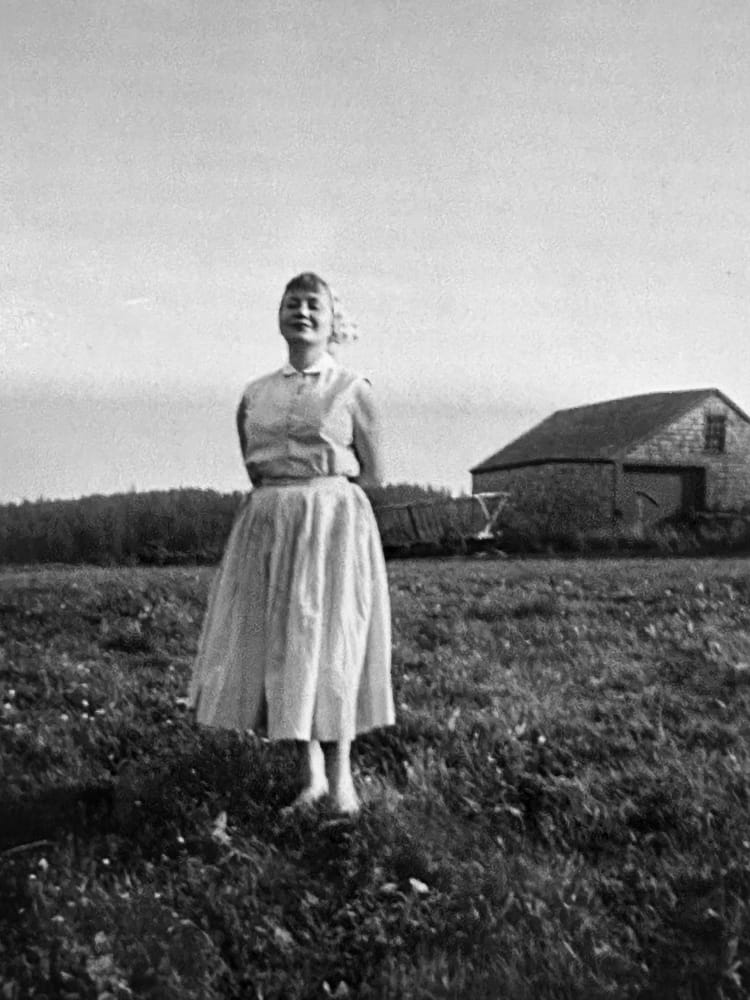
Lewin's works are united by a strong formal instinct and a singular, complex vision of reality.
Full of enigmatic symbolism and stylistic approaches that draw richly from Cubism and Surrealism, the work of Ruth Lewin (1924-1975) has been overlooked despite its significant role in American abstraction as part of the Indian Space Painters, a group that sought to develop new pictorial space using techniques and ideas inspired by Native American art. In the early 1940s, Lewin studied printmaking at the Art Students League in New York with artist Will Barnet, who was a prominent teacher at the institution. As monitor of Barnet’s classes, Lewin absorbed his lessons on Cubist principles as well as his keen interest in the art of Northwest Coast Native Americans. Barnet often brought his students, including Lewin, to see exhibitions of Native American art at the Museum of Natural History.
Lewin, along with Steve Wheeler, Robert Barrell, Peter Busa, Will Barnet, and Howard Daum, became part of the Indian Space Painters group (though Lewin was part of the second, younger group of artists who formed the group). Informed by what they saw as the pre-linguistic, metamorphic forms of art made by Northwest Coast Native Americans that mixed image, symbol, and myth, this group’s new aesthetic sought to combine the formalism of Cubism with the inner vision of Surrealism. Barnett Newman described the symbolic images made by the Northwest Coast indigenous people as a "shape [that] was a living thing, a vehicle for an abstract thought-complex." According to Sandra Kraskin, “the Indian Space artists, then, were attempting to work out an indigenous American aesthetic just prior to and then concomitant with Abstract Expressionism. They served to bridge the gap between the purely abstract bent of the American Abstract Artists (AAA) and the later, more emotional style of Abstract Expressionism. Their interests pointed to the eventual assimilation of the principles of the European masters within the context of the American-derived Indian Space.” (1)
In addition to drawing inspiration from Native American art, Lewin’s works often metabolize and play with the influence of Picasso and his Cubist tenets of restructuring pictorial space (while retaining the distinction between figure and ground). Her works often focus on the flattening of the picture plane, seamlessly merging positive and negative space, as well as the use of iconography that expresses a vision of the modern world’s ethical issues, urban landscapes, and psychic conflicting forces. Skeletal, attenuated figures––reminiscent of Wifredo Lam’s jagged figures––populate many of her works, and the Surrealist influence is visible in the macabre but undeniably human pathos shot through her works. Lewin also experimented with abstract landscapes, as well as Cubist portraits that insist on their flatness and emphasize their use of the line. Her works are united by a strong formal instinct and a singular, complex vision of reality.
Lewin painted until her death in 1975. Right before she died, she completed 25 small acrylic works of city rooftops. Painted from photographs, these paintings were worked in a totally different style from her prior works. She was married for 27 years to the artist Charles Seliger, with whom she raised two sons. Her work is held in the collections of the National Gallery of Art, Washington D.C.
1. Sandra Kraskin, “The Indian Space Painters: Native American Sources for American Abstract Art,” in The Indian Space Painters: Native American Sources for American Abstract Art, exhibition catalogue, Baruch College, New York, November 8-December 17, 1991.









![Ruth Lewin, Untitled (Abstracted Figure], n.d.](https://artlogic-res.cloudinary.com/w_800,c_limit,f_auto,fl_lossy,q_auto/artlogicstorage/htg1979/images/view/24a6a66385c1430ffb3d0ac063beda41j/hollistaggart-ruth-lewin-untitled-abstracted-figure-n.d..jpg)
![Ruth Lewin, Untitled [Abstracted Figures], n.d.](https://artlogic-res.cloudinary.com/w_800,c_limit,f_auto,fl_lossy,q_auto/artlogicstorage/htg1979/images/view/3c77cd4382228c78e7d2bad1d481fe49j/hollistaggart-ruth-lewin-untitled-abstracted-figures-n.d..jpg)
![Ruth Lewin, Untitled [Abstracted Female Nude], n.d.](https://artlogic-res.cloudinary.com/w_800,c_limit,f_auto,fl_lossy,q_auto/artlogicstorage/htg1979/images/view/9fec70d89bbd34ddc4fbff63ee3b75a0j/hollistaggart-ruth-lewin-untitled-abstracted-female-nude-n.d..jpg)
![Ruth Lewin, Untitled [Surrealist Landscape], n.d.](https://artlogic-res.cloudinary.com/w_800,c_limit,f_auto,fl_lossy,q_auto/artlogicstorage/htg1979/images/view/e28605f7c3da26680b7881d9fc081382j/hollistaggart-ruth-lewin-untitled-surrealist-landscape-n.d..jpg)
![Ruth Lewin, Untitled [Abstracted Face], n.d.](https://artlogic-res.cloudinary.com/w_800,c_limit,f_auto,fl_lossy,q_auto/artlogicstorage/htg1979/images/view/e96fa448b93b788013a765fdd34f4559j/hollistaggart-ruth-lewin-untitled-abstracted-face-n.d..jpg)
![Ruth Lewin, Untitled [Couple in a Cityscape] [double-sided], n.d.](https://artlogic-res.cloudinary.com/w_800,c_limit,f_auto,fl_lossy,q_auto/artlogicstorage/htg1979/images/view/20a74438ac1a96018489bdb232efa58fj/hollistaggart-ruth-lewin-untitled-couple-in-a-cityscape-double-sided-n.d..jpg)
![Ruth Lewin, Untitled [Face], n.d.](https://artlogic-res.cloudinary.com/w_800,c_limit,f_auto,fl_lossy,q_auto/artlogicstorage/htg1979/images/view/7645d3beb7141cb9b524080555c434a5j/hollistaggart-ruth-lewin-untitled-face-n.d..jpg)
![Ruth Lewin, Untitled [Abstraction], circa 1945](https://artlogic-res.cloudinary.com/w_800,c_limit,f_auto,fl_lossy,q_auto/artlogicstorage/htg1979/images/view/26e5dd6dcfa436352835f8016fe61db6j/hollistaggart-ruth-lewin-untitled-abstraction-circa-1945.jpg)
![Ruth Lewin, Untitled [Abstraction], circa 1940s](https://artlogic-res.cloudinary.com/w_800,c_limit,f_auto,fl_lossy,q_auto/artlogicstorage/htg1979/images/view/eed461d8ca6daca82a40630ec54deb76j/hollistaggart-ruth-lewin-untitled-abstraction-circa-1940s.jpg)
![Ruth Lewin, Untitled [Coney Island], 1955](https://artlogic-res.cloudinary.com/w_800,c_limit,f_auto,fl_lossy,q_auto/artlogicstorage/htg1979/images/view/bb82c7d57e2b020204f997d16fd8b5ccj/hollistaggart-ruth-lewin-untitled-coney-island-1955.jpg)
![Ruth Lewin, Untitled [Abstraction], circa 1945](https://artlogic-res.cloudinary.com/w_800,c_limit,f_auto,fl_lossy,q_auto/artlogicstorage/htg1979/images/view/3dba53088acbe93e0828493106cce746j/hollistaggart-ruth-lewin-untitled-abstraction-circa-1945.jpg)

![Ruth Lewin, Untitled [Skeletal Figure with Baby and Children], n.d.](https://artlogic-res.cloudinary.com/w_800,c_limit,f_auto,fl_lossy,q_auto/artlogicstorage/htg1979/images/view/ded09558377c3354ffe03ee70e9cc8d2j/hollistaggart-ruth-lewin-untitled-skeletal-figure-with-baby-and-children-n.d..jpg)











